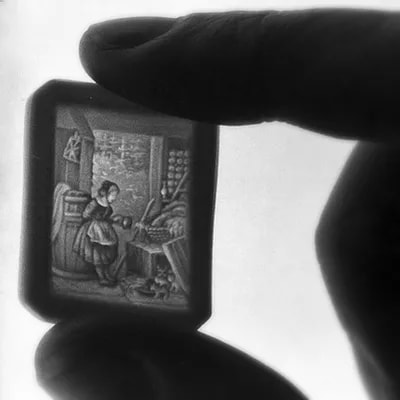
MUSEUM HISTORY
The Blair Museum of Lithophanes was founded by Laurel Gotshall Blair (1909-1993), a native Toledoan whose father had opened the Blair Realty and Investment Company in 1908. Blair Realty was a major developer in Toledo in the 1920s, creating such communities as the upscale Heatherdowns area with its own country club. Mr. Blair attended Scott High School and the University of Michigan, and like his father before him, served as President of the Toledo Board of Realtors.
A born collector, Laurel Blair, first discovered lithophanes in October 1961. He was attending a meeting of some collectors from the International Music Box Society in Berlin Heights, Ohio. There he saw something he’d never seen before -- two delicate porcelain pictures magically illuminated by the sunlight -- hanging in the window. He learned they were “lithophanes” and, as he later wrote, he “fell in love.”
Over the next several decades, Mr. Blair, truly a world traveler, amassed the largest collection of lithophanes in the world. In March, 1965, he opened a private museum in his home, displaying more than a third of his collection of over 2,300 lithophanes.
Prior to his death in 1993, Mr. Blair donated his collection to the City of Toledo. Dedicated volunteers worked diligently for nearly ten years, photographing and cataloguing the collection, and overseeing the renovation of a building located at the Toledo Botanical Garden. In July 2002, the new museum opened to the public in its transformed space.
Now the Blair Museum is happy to call Schedel Arboretum and Gardens home as of September 2020. With the Metroparks purchase of the Toledo Botanicla Gradens, the Blair Museum was asked to leave. The Friends of The Blair Board worked diligently for a year to secure a new home for the Lithophane collection. The city of Toledo graciously handed over possession of the Blair Museum to Schedel. We are now in the process of converting the Schedel's Manor house into the Blair Museum of Lithophanes. We will be open to the public again on April 1st 2021.
The Blair Museum of Lithophanes was founded by Laurel Gotshall Blair (1909-1993), a native Toledoan whose father had opened the Blair Realty and Investment Company in 1908. Blair Realty was a major developer in Toledo in the 1920s, creating such communities as the upscale Heatherdowns area with its own country club. Mr. Blair attended Scott High School and the University of Michigan, and like his father before him, served as President of the Toledo Board of Realtors.
A born collector, Laurel Blair, first discovered lithophanes in October 1961. He was attending a meeting of some collectors from the International Music Box Society in Berlin Heights, Ohio. There he saw something he’d never seen before -- two delicate porcelain pictures magically illuminated by the sunlight -- hanging in the window. He learned they were “lithophanes” and, as he later wrote, he “fell in love.”
Over the next several decades, Mr. Blair, truly a world traveler, amassed the largest collection of lithophanes in the world. In March, 1965, he opened a private museum in his home, displaying more than a third of his collection of over 2,300 lithophanes.
Prior to his death in 1993, Mr. Blair donated his collection to the City of Toledo. Dedicated volunteers worked diligently for nearly ten years, photographing and cataloguing the collection, and overseeing the renovation of a building located at the Toledo Botanical Garden. In July 2002, the new museum opened to the public in its transformed space.
Now the Blair Museum is happy to call Schedel Arboretum and Gardens home as of September 2020. With the Metroparks purchase of the Toledo Botanicla Gradens, the Blair Museum was asked to leave. The Friends of The Blair Board worked diligently for a year to secure a new home for the Lithophane collection. The city of Toledo graciously handed over possession of the Blair Museum to Schedel. We are now in the process of converting the Schedel's Manor house into the Blair Museum of Lithophanes. We will be open to the public again on April 1st 2021.

